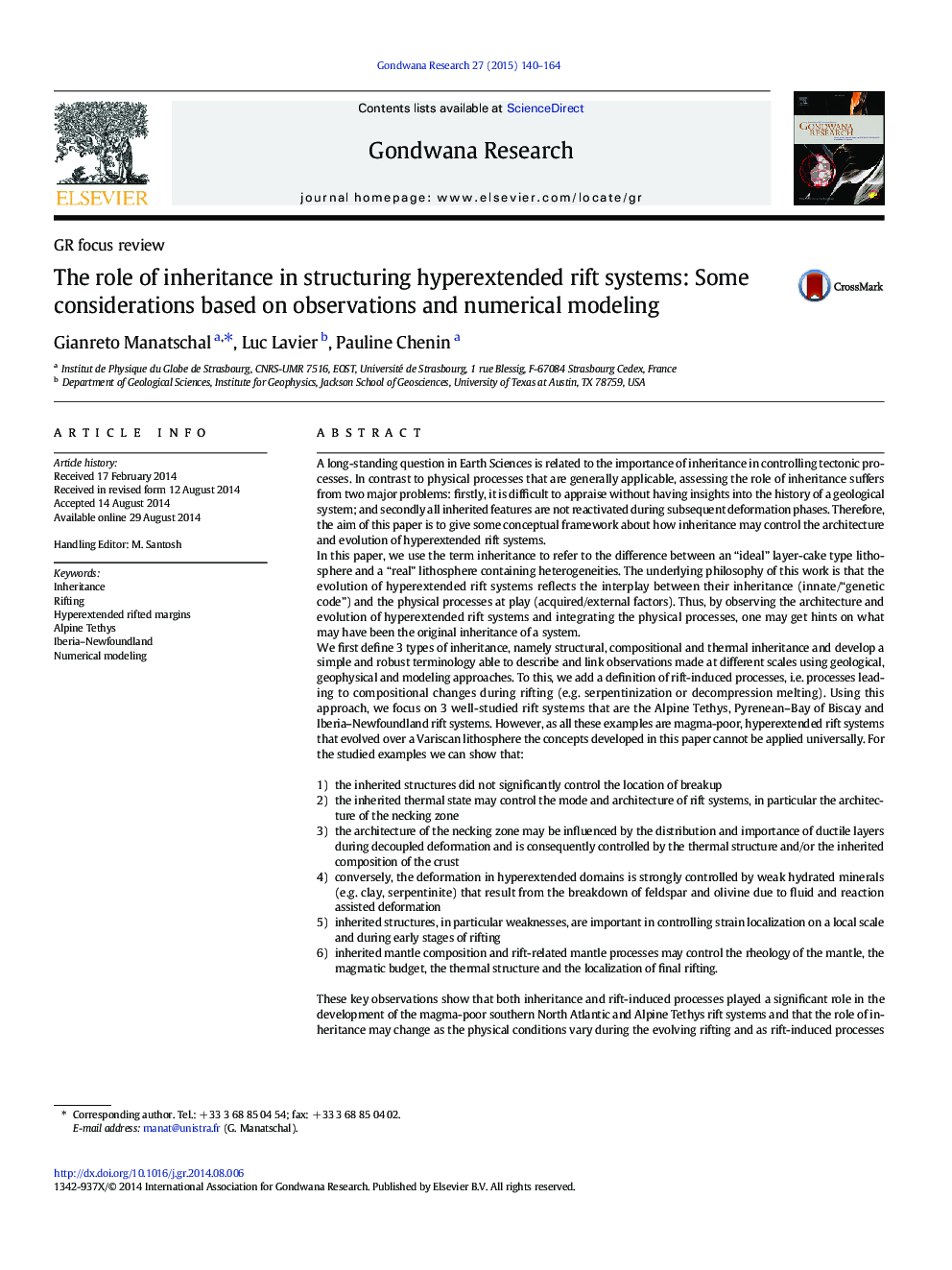| کد مقاله | کد نشریه | سال انتشار | مقاله انگلیسی | نسخه تمام متن |
|---|---|---|---|---|
| 4727180 | 1356364 | 2015 | 25 صفحه PDF | دانلود رایگان |
• Ductile layers control deformation mode and rift architecture during early rifting.
• Hydrated minerals and magma additions control deformation in hyperextended domains.
• Mantle controls location of necking, magmatic budget and thermal structure.
• Inheritance controls neither location of breakup nor nature of first oceanic crust.
A long-standing question in Earth Sciences is related to the importance of inheritance in controlling tectonic processes. In contrast to physical processes that are generally applicable, assessing the role of inheritance suffers from two major problems: firstly, it is difficult to appraise without having insights into the history of a geological system; and secondly all inherited features are not reactivated during subsequent deformation phases. Therefore, the aim of this paper is to give some conceptual framework about how inheritance may control the architecture and evolution of hyperextended rift systems.In this paper, we use the term inheritance to refer to the difference between an “ideal” layer-cake type lithosphere and a “real” lithosphere containing heterogeneities. The underlying philosophy of this work is that the evolution of hyperextended rift systems reflects the interplay between their inheritance (innate/“genetic code”) and the physical processes at play (acquired/external factors). Thus, by observing the architecture and evolution of hyperextended rift systems and integrating the physical processes, one may get hints on what may have been the original inheritance of a system.We first define 3 types of inheritance, namely structural, compositional and thermal inheritance and develop a simple and robust terminology able to describe and link observations made at different scales using geological, geophysical and modeling approaches. To this, we add a definition of rift-induced processes, i.e. processes leading to compositional changes during rifting (e.g. serpentinization or decompression melting). Using this approach, we focus on 3 well-studied rift systems that are the Alpine Tethys, Pyrenean–Bay of Biscay and Iberia–Newfoundland rift systems. However, as all these examples are magma-poor, hyperextended rift systems that evolved over a Variscan lithosphere the concepts developed in this paper cannot be applied universally. For the studied examples we can show that:1)the inherited structures did not significantly control the location of breakup2)the inherited thermal state may control the mode and architecture of rift systems, in particular the architecture of the necking zone3)the architecture of the necking zone may be influenced by the distribution and importance of ductile layers during decoupled deformation and is consequently controlled by the thermal structure and/or the inherited composition of the crust4)conversely, the deformation in hyperextended domains is strongly controlled by weak hydrated minerals (e.g. clay, serpentinite) that result from the breakdown of feldspar and olivine due to fluid and reaction assisted deformation5)inherited structures, in particular weaknesses, are important in controlling strain localization on a local scale and during early stages of rifting6)inherited mantle composition and rift-related mantle processes may control the rheology of the mantle, the magmatic budget, the thermal structure and the localization of final rifting.These key observations show that both inheritance and rift-induced processes played a significant role in the development of the magma-poor southern North Atlantic and Alpine Tethys rift systems and that the role of inheritance may change as the physical conditions vary during the evolving rifting and as rift-induced processes (serpentinization; magma) become more important. Thus, it is not only important to determine the “genetic code” of a rift system, but also to understand how it interacts and evolves during rifting. Understanding how far these new ideas and concepts derived from the well-studied hyperextended rift systems of the southern North Atlantic and Alpine Tethys can be translated to other less explored hyperextended rift systems will be one of the challenges of future research in rifted margins.
Figure optionsDownload as PowerPoint slide
Journal: Gondwana Research - Volume 27, Issue 1, January 2015, Pages 140–164
